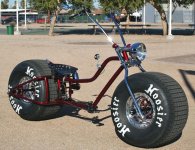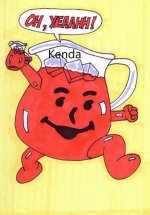ITS NOT THE RIM ITS THE TIRE! I don’t give a dam about the rim as that is not what we run on. It’s the rubber and how it sticks to the road that counts. Traction is very important and the heavier the vehicle the harder the rubber compound has to be and therefore the longer the tire lasts. Sport bike tires barely get 6k before they’re worn out.
Spyders are pretty much the heaviest of motorcycles but not heavy enough for the harder car tires. Spyder have extremely sensitive traction sensors and it’s why many rider experience limp home mode.
Putting a car tire on a 2 wheeler is questionable as 2 wheelers ride the way they do BECAUSE of their ability to corner by leaning. I’ve known quite a few that tried it and found out it ruins the ride and are honest enough to admit it was a stupid idea. I’ve known 2 that lost their Wings because of an accident (one was due to the tire, one not) and the insurance didn’t pay out.
The bottom line is most Spyder owners have no motorcycle experience and are surprised at how much it costs to own/operate a motorcycle.
Sorry Flamewinger, but the
RIM is an
EXTREMELY IMPORTANT part of the equation, and yes, so is the compound, and the way the tire's constructed, and the pressure you run that tire at, and a few other things besides... :lecturef_smilie: But without the
RIM and the different shape & size of its
Bead to suit the different
Bead Profile on the Motorcycle tire, that tire
WILL NOT work! And a
LOT of the safety issues with going to the 'darkside' by putting an auto tire onto a Motorcycle Rim comes from the way the bead profiles of the rim and tire don't match, meaning they don't work to hold the tire on the rim all that much at all, instead leaving the majority of that task up to the forces imposed by the air pressure inside the tire and the strength of the tire's sidewall... Only just like the Bead and the shape/construction of the tread, an auto tire sidewall is a whole 'nuther animal to that of the sidewall in a Motorcycle tire.

What it all comes down to is that
Motorcycle tires are a completely different animal to
car tires, not only in the way they are constructed and the tread patterns, but also in the compounds, the angles of the plies inside the rubber, and a bunch more technical things besides; and because (amongst other things) they
AREN'T flat-ish across the tread, and they
AREN'T round either - they are a carefully designed shape that starts out with a sorta oval contact patch when they are stationary and upright, but that contact patch then changes its size and shape as they move & lean, enabling them to turn. Without leaning (which is effectively
ONLY induced by counter-steering) and putting a very different set of stressors onto their sidewalls, beads, and rims, motorcycles & their tires just don't turn
AT ALL! (There's even a pretty good vid out there by FortNine showing all this, and why motorcycles only turn by counter-steering, you might want to check it out.

)
However, Car tires, like those fitted to any auto you might drive on the road,
AND those fitted onto our Spyders (and on the rear of HD Trikes too)
ARE ALL constructed almost completely differently with respect to the detail of those tread patterns, compounds, angles of the plies etc, etc, because they
DO NOT LEAN anywhere near as much in order to make the vehicle turn and their tread needs to be kept fairly flat & in contact with the road surface via a rectangular shaped contact patch that doesn't/shouldn't change shape very much during cornering, again putting a completely different set of stressors onto
their beads & rims; cos with a car tire, be it on an auto or a Spyder or even on the rear of an HD Trike, it's not the
LEAN that makes them turn like it does on a 2-wheeled motorbike, it's the act of steering the machine that turns wheels across the direction of travel and induces all sorts of twisting forces and slip angles and other esoteric stuff that make that happen, something motorcycle tires simply do not do or need to do to anywhere near the same extent... Which is yet another reason why it's called '
going to the darkside' when you fit a car tire onto a 2-wheeled motorcycle - cos with a car tire fitted on a motorcycle (and especially on a motorcycle rim, with their different bead profiles...

) you're fitting a
tire that is designed to & needs to hold its tread as flat as it can onto the road and then be
steered in order to induce a turn, onto a machine and a
rim that is designed to and needs to
Lean to turn so that the lean changes the shape of the contact patch and effectively enables the turn... only the car tire is simply not made to turn like that, so not only won't the car tire tread & sidewalls like it, but also its bead won't fit/match &/or grip the motorcycle rim properly, and the car tire bead simply isn't made or ever intended to withstand those specific stressors that leaning as opposed to turning impose upon the rim & the completely mismatched bead profiles! :shocked:
And in the interests of not boring the crap outta everyone else with a condensed version of about 6 years of study and many more years of experience, the
REAL Bottom Line here is that while you might be right in what you say about
SOME few Spyder Owners, it's not really relevant, cos the tires fitted to our Spyders, no matter what other 'labels' might be placed on them,
are still for all intents and purposes, CAR TIRES - they are car tires in their design; their construction; their tread compound; the way the plies are angled; in their beads and bead profiles; in the rims they fit onto & the rims they
don't fit onto; in their tread patterns; in the way they are steered to induce turns; in the whole kit and kaboodle -
they are CAR TIRES! And the OEM tires on our Spyders work just like all the other car tires out there in every respect, even down to the way the air pressure in those tires needs to be adjusted to suit the construction features of the car tire in order to match the load that the tire is carrying and enable all the bits that work together do their job as they should - lightly constructed tires need more air pressure in them to carry a given load, like the load of your Spyder, and still allow the tread compound to warm up and reach its operating temperature in order to do their thing properly; while heavier/stronger/higher load rated tires need proportionally less air pressure in them to carry that same given load, the lighter load of a Spyder when compared to that of the heaviest vehicle they could carry, and yet still let the tread compounds reach their operating temperatures and do their thing properly...

hyea:
This isn't rocket science, it's just like if you fit a given size & type of car tire onto a Mini Cooper or a Mazda Miata, it'll need to run proportionally lower air pressure to that required if you fitted exactly the same size & type of car tire onto a much heavier vehicle, like saaay, a fully loaded Volvo station wagon or a Mazda CX30. You don't always
NEED or even
WANT to run any tire at or near its maximum pressure/maximum load rating if you're not making them carry that much load; cos by running lower pressures it'll
still be perfectly capable of carrying a lesser load than its maximum - funnily enough, they are designed and made that way! And if you
DO run it at its maximum pressure when you're only imposing a significantly lighter load than its maximum rated load, then you'll be doing the tire, your vehicle, yourself, and all the other road users around you or who might travel on that road after you a disservice.

A lower load than the tire's maximum load = the need for a lower air pressure in it than the tire's maximum, just like we've been saying for a long time when running A/mkt car tires on our Spyders - the lower the load imposed, the lower the air pressure required. :thumbup:
Just Sayin'
 Ps:
Ps: While they both run Motorcycle tires, Sport bike & Touring bikes have different tire cross-section/profiles because they want/need different performance characteristics from a given amount of lean - Sport bikes want to turn quicker & at higher speeds; so as the bike leans, the shape of the contact patch changes more significantly than that of the Touring bike, which really doesn't want quite the same sudden and rapid turn-in for the slightest bit of lean; they generally want greater stability and a more relaxed but progressive turn-in as the lean increases. Check out that vid from FortNine, it's good value for most who might be having difficulties in understanding this concept. :thumbup:
Edit: Added the link - this is how Motorcycles turn, and how their tires enable that:
https://www.youtube.com/watch?v=vSZiKrtJ7Y0
Our Spyders/Rykers don't work like that at all, cos they don't lean much and they have car-like suspension and steering, so they need to run tires that'll let them steer just like cars...




